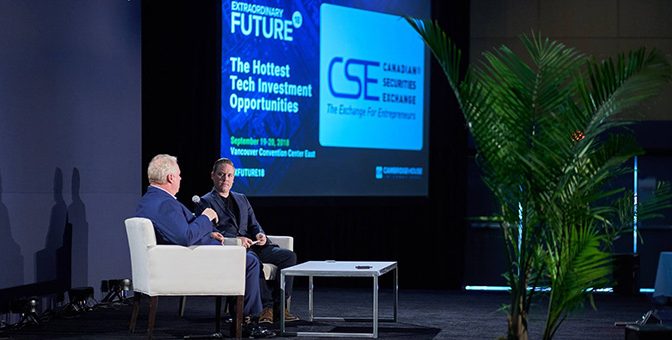PM: As we approach the end of 2018, the CSE is positioned to report another year of records in trading volume, trading value, financings, and other metrics illustrating the exchange’s success. What achievements stand out in your mind, and why are they important to your vision for where the CSE is going?
RC: Clearly, standout events have been taking place over the last few months, with the number of very large US-based cannabis issuers that have joined the CSE. It is companies such as Curaleaf, Harvest Health, Acreage, Green Brands, and more to come over the next few months. We are seeing the most rapid expansion of market capitalization and impact on the exchange since our inception.
I will say that the opportunity to work with management teams who are representing, in some respects, the pinnacle of US business is one that the CSE really values. Finance professionals and advisors are involved from bulge-bracket US brokers. And there are experts highly experienced in consumer products and the consumer packaging industry from companies such as Procter & Gamble.
The opportunity to work with people of this calibre is validation of the proposition that the CSE has been working to build and illustrates that we are headed in the right direction.
Back to top
PM: Cannabis continues to be a big driver of the growth being experienced by the CSE. In 2018, the sector brought several of the largest financings to ever take place on the exchange, and some of the issuers have market caps that place them well beyond the microcap category. Does the increasing size of the average listed company present any new opportunities or challenges?
RC: I don’t know that the increasing size presents any unique challenges. Certainly, what it means is that, given the size of the financings and the overall enterprise value of these companies, we are seeing, for the first time, significant institutional participation. This is a very important development, because last year and in the early part of this year the money was principally coming out of the retail space or Canadian accredited investors through private placement financings.
What we are seeing now is institutions from Europe, the United States, Canada and Asia participating in these financings. And this really is the first time we have had this community involved with the Canadian Securities Exchange.
We are being exposed to advisors in the United States who are beginning to understand that the Canadian public equity markets are in fact a viable alternative for US companies looking for growth capital. We’ve had conversations with a number of these professionals about taking what we have learned from the capitalization efforts in the US cannabis space and applying that to companies from other sectors that perhaps have not been that well served by the venture capital and private equity models that are the principal source of growth capital for early stage US companies.
That is a thesis we have had for a number of years and I think the cannabis industry is bringing the capabilities of our market to light. And not just of the Canadian Securities Exchange, but really the whole ecosystem that we represent, be it the investment dealers or the law firms that work with these issuers. We really do hope to leverage the relationships that we have built in the cannabis space to bring a whole new category of companies into the Canadian public equity markets.
Back to top
PM: The CSE remains the best choice for companies in the cannabis sector looking to list in Canada, especially those with assets in the United States. What will be the approach to protecting the CSE’s lead in cannabis listings if the US chooses to make cannabis legal on a federal level, thus opening the door to cannabis companies listing on US exchanges?
RC: We have been asked this question quite frequently over the last little while, and I think the answer falls somewhere along the following lines. In my experience in the exchange business in Canada, people have always looked at market share of trading for inter-listed companies between Canada and the United States and tried to think about how to change that dynamic. How do we increase market share? How do we increase order flow from the United States?
The simple fact of the matter is that the percentage of market share is almost exactly the same as the percentage of the country of residence of the shareholders.
To illustrate, if a company has 50% of its shareholders resident in Canada and 50% in the United States, the market share of trading if the company is listed on both a Canadian and US exchange is about 50/50. There is not a lot you can do about that because of regulations that make it difficult for dealers in the United States to route client order flow to Canada, and Canadian dealers to route order flow to the United States.
There is a little bit of a closed shop operating. What we will have to do is look at which companies have a predominantly Canadian shareholder base and convince them to retain their Canadian listing as and when regulations are further loosened in the United States and cannabis is removed from Schedule 1 of the Controlled Substances Act.
One of the other things we are going to be looking to do is develop some index products early in 2019 around the US cannabis space. We are the only location globally where you see as heavy a concentration of US cannabis issuers, so we are the logical place for that index to be calculated and disseminated.
Obviously, what we would like to see is exchange traded fund products developed off that index, so that people are able to not just purchase the equities of individual companies but diversify across the entire sector with an exchange traded fund product. That is another way in which we hope to increase the stickiness, if you will, of the relationships we develop with these issuers.
And last, but not least, we want to continue to build deep relationships with the management teams of these companies and put ourselves in that situation kind of like Nasdaq back in the day, when Microsoft and Cisco and Intel and Apple and all of those companies didn’t qualify for the New York Stock Exchange. And when they did, and the New York Stock Exchange knocked on their door and said, “Hey, Mr. Gates, it’s time to move up to the Big Board,” Bill Gates said, “No thanks, we are very well served by our present exchange relationship.” So, that is the kind of brand loyalty we would like to build with these management teams and service them well into the future regardless of how the regulatory landscape changes.
Back to top
PM: How about other industry sectors on the exchange?
RC: It is interesting because the cannabis space has obviously had the headlines, but we have in fact seen a significant number – and in absolute numbers almost a record – of mining companies get onto the exchange and receive funding this year.
My sense is that some of the profits from trading in the cannabis space over the last couple of years are being applied to the mining sector. Notwithstanding the fact that there is a drag on the mining sector right now because of the low price of most of the commodities, we are seeing mining companies get funded and come onto the exchange at a higher rate than in many years. And as I say, it gets a little bit lost in the shuffle of all the cannabis news, but they are getting funded in quite considerable numbers at this point.
In tech, we are seeing some struggles in the crypto space and that seems to have put a chill on the entire blockchain sector, which was red hot just a year ago. But we are also seeing a number of technology stories get funded. We would like to see more and that is one of the great focuses of our efforts with the new business relationships we are developing in the United States. Having a pipeline of companies in the tech sector from the US come public here would be very interesting for investors.
Back to top
PM: The amount of capital being raised by companies on the exchange continues to skyrocket – it looks as if the final number for 2018 is going to settle somewhere around $5 billion. You can’t reach this level without funds playing a big part. Can you comment on the changing role of institutional investors in the CSE marketplace?
RC: As I mentioned, we are seeing great institutional participation in financing transactions as they get larger and larger. And one headline from the Curaleaf financing, which was approximately $520 million, was that there was something like a hundred institutions, as I understand it, on the investor list. We know that institutions have increasingly participated in the space as the year has progressed. Large institutions from all over the world are beginning to participate in this space, and as I mentioned we want to work with these people, ensure they have a good experience, and that they are prepared to back CSE listed stories again in the future.
Back to top
PM: Marginability is an important issue for many large investors and the CSE has been working to achieve some changes in the way this is managed. Why is this issue important and what can you tell us about where the discussion is headed?
RC: The marginability issue has a number of different components to it, but you can essentially look at things in two ways. If the shares of a company are not margin-eligible, it means an investor cannot hold the shares in a margin account, and the dealer cannot lend them money to purchase the shares. Instead, the investor must use cash to purchase them.
Many higher priced securities are margin-eligible. With these securities, an investor doesn’t have to use most, or all, of the money in their account to make a purchase and can instead borrow from their broker.
The other way this impacts issuers is that the dealer is required to post capital with the clearing house against the possibility of failure on the other side of the trade. And that is what people mean when they refer to T+2: the transaction is only finally settled after two days plus the day of the trade, when it clears with securities and cash changing hands.
The dealers are required to post capital against the potential of that trade failing – in effect one side not showing up with the stock or cash to settle it.
For margin-eligible securities, they don’t have to post the full amount. The idea is that it is not volatile, there is lots of value there, the likelihood of failure is low, and if there was a default you could sell the shares to get the money.
For companies that aren’t margin-eligible, the dealers have to post 135% of the trade value with the clearing house. To be eligible, a stock has to trade at a price higher than $3.00, so there is a relatively small number of stocks trading on the CSE that qualify.
We are looking to help dealers free up capital in two ways. One is being able to provide customer service in their margin accounts. And the second way is to reduce the capital posted at the clearing house in the two-day settlement cycle.
We are working with regulators to remedy this situation as quickly as we can. And we have reason to believe that we have made a good deal of progress. When change takes place, it certainly should increase the liquidity of the stocks. It will certainly make them less expensive for people to trade. And it should bring even more participation in CSE names.
Back to top
PM: What can you tell us about the blockchain-enabled clearing and settlement facility you have been working on?
RC: We are in the late stages of quality assurance on the new system. We have been working with our developer to make some changes on the robustness of the system. And this is really in anticipation of questions and comments we would receive from the users and from the regulators.
We hope to get the system up in our external test environment so that dealers and some other interested parties can begin testing in their own environments before Christmas. And at that point we will be working closely with them to understand what our timelines are from an implementation perspective. We have to respect the amount of work the dealers will have to do to integrate their existing cash management systems and client reporting systems into our clearing settlement facility. We’re hopeful that the effort will not be too lengthy and we’re pleased that there is a relatively small number of vendors who provide the services. So, it’s not a case where 125 dealers suddenly have to make changes, but one where a small number of vendors have to make changes that will then be extended to the entire industry.
Dealers continue to be extremely eager to get their hands on it. They understand the business case and the client service benefits, as well as the number of companies that would like to use security tokens as a means of securing capital. We continue to be very excited about this facility and it is going to be one of the things on the agenda for 2019.
Back to top
PM: The exchange’s Toronto team is relocating to a new space early in 2019 — First Canadian Place. Insofar as you can comment, how well is the exchange doing as a business, and how does this provide you with new and/or better resources to make the organization even stronger?
RC: We are a private company, so our financials are not available publicly. I will say, and this should come as no surprise to anybody, that with the volume of trading and listings we’ve had this year, as well as continued strong performance from our market information businesses, the exchange is on very solid financial footing.
We will be moving to new premises early in the New Year. This was really brought on by the anticipated growth in our staffing levels, particularly in the listings regulation area. It is important that we continue to maintain high service levels for our issuers and deploy our regulatory responsibilities as an exchange.
At this point, it is a pretty tight fit for the team at our present location. As well, and I think this is one of the important incentives for us to move to new premises, we really want to provide a better listings and presentation experience for our issuers. Everybody expects a bell-ringing or market-opening ceremony with a proper backdrop. The new First Canadian Place location will give the space and a spectacular backdrop to have exactly that kind of experience for the issuers. We really want to be able to step up our game with providing companies a memorable experience on their first day of trading, or whenever they have the opportunity to visit the exchange and have their listing recognized by us and the rest of the community. We are all really excited about moving into the new premises, probably at some point toward the end of January.
Back to top
PM: As we head into 2019, what can issuers and investors anticipate from the CSE? And looking further into the future, how is the CSE positioning itself to keep momentum going into 2020 and beyond?
RC: We covered the outlook in some detail already, but I’ll elaborate on a few items. The blockchain initiative will be a significant focus for the organization as we move into 2019. And it will take much of the year before it is ready. That will give us a great platform to track new and interesting securities in the marketplace.
I also mentioned new index products with a cannabis focus. Again, we are the most logical source in the world to provide those sorts of index products. And clearly our motivation there is to provide those indices as an underlying interest for ETF products. My sense from traveling in the US recently is that we have many more companies of significant size, business operations and profits who will be looking to come into the Canadian market to fund further growth and provide liquidity for their early stage investors.
Over and above that, we will be building out the CSE team. We plan to pay particular attention to the continuous disclosure program for existing companies. As we attract issuers with larger and more complex business operations, we need to do more work with them to ensure they stay on top of their continuous disclosure requirements under the Ontario Securities Act.
We hope that we can realize improvements to margin eligibility for stocks early in 2019 and we believe that would further improve liquidity in the marketplace.
We will continue to build relationships with markets around the world. As I think is well known at this point, we have a close working relationship with the OTC Markets Group in the United States. CSE issuers have had a very positive experience working with them in building liquidity, adding to the shareholder base, and as a platform for fundraising activities in the US. And we are looking to build partnerships in the UK, in Australia and the European Union to provide similar managed relationships with marketplaces in those jurisdictions.
Having a dual-listing or an over-the-counter arrangement really does help the ability of companies to raise funds in those marketplaces. And given the existence of sophisticated arbitrage trading, it can help to build an even better liquidity profile.
Building relationships with more international companies choosing to access Canadian markets for capital to expand their businesses is also an important agenda item. I visited Israel twice this year and we expect to see the first Israeli companies list toward the end of this year or early in 2019. We will see a healthy cohort of companies from Israel – some of them are in technology, some are in the cannabis space. We want to see people in different markets around the world look to Canada and our world-leading position in small-cap finance to help them secure growth capital.
Back to top



















